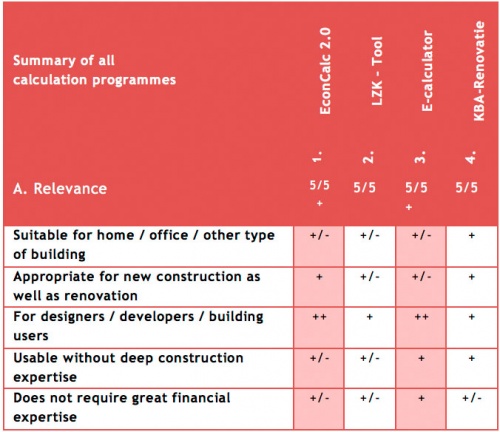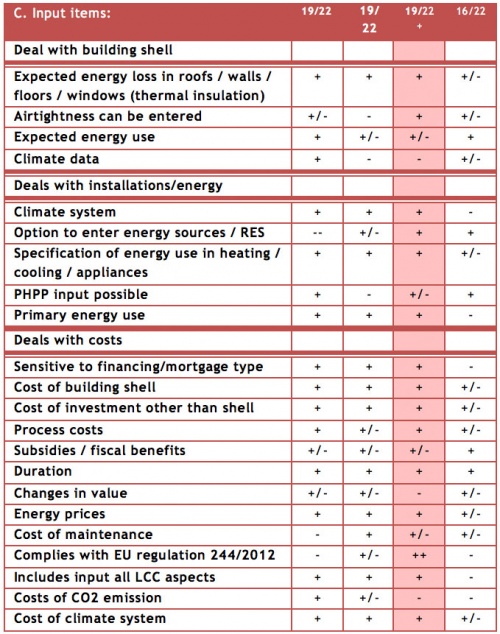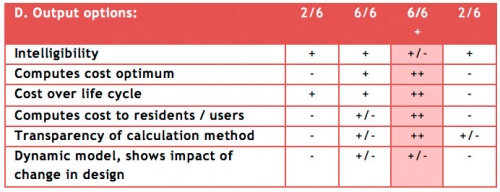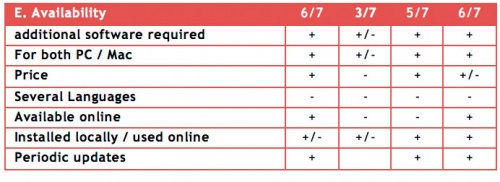Calculation programmes for feasibility studies of low energy renovations
For PassREg, Azimut Bouwbureau investigated a number of calculation programmes suitable for LCC-analysis of energy oriented renovations.
The renovation may include interventions in the structure (e.g. improved insulation, air tightness) or in the installed systems (e.g. for heating, hot water, ventilation, heat recovery, sustainable energy generation) or both. All the programmes included in the survey compare the costs of these improvements to the savings that can be expected on subsequent energy and other operational bills.
Contents
Short description of the analysed programmes
Four programmes were selected for further investigation: EconCalc 2.0; LZK–tool; E-calculator and KBA-Renovatie. These were subjected to criteria such as relevance, scope, input opportunities, output options and accessibility. The four programmes can be characterised as follows:
1. Econ calc
This programme offers a wide range of input possibilities. By featuring an example application, it helps the user to make use of all these input options. One of its strong points is that it can juxtapose five variations of the renovation of a particular building.
2. LZK-tool
This programme is very elaborate yet easy to use. It was created by a consultant office for their own use in new construction. Presently, they are developing a version even more tailored to renovations. That version, however, is not available yet.
3. E-calculator
This Belgian calculation programme follows the perspective of the entire life cycle and includes a residual value of the building. A distinguishing element of this programme is that it will identify the set of renovation interventions that is optimal from a cost point of view. So it does more than just calculate the life cycle cost of interventions as entered.
4. KBA-renovatie
This computation tool will provide a quick and clear impression of the energy quality after renovation. It is not very comprehensive on the life cycle aspect, but can be used in a first orientation.
Recommendation
The calculation programme ‘E-calculator’ stands out in this comparison. It was developed by the Knowledge Centre on Energy (KCE) of the Catholic University (KU) at Leuven, Belgium and Thomas More. In addition to computing the return on investment, it can suggest combinations of retrofitting interventions to obtain an optimal return on investment for the building involved. However, this programme is cumbersome to use, takes a lot of computer time and is not available in English. The same software development team is presently preparing a more user friendly version that will focus more clearly on renovation projects.
Although this programme in its present form is aimed at new construction projects, it is helpful for renovation plans as well. The programme complies with the relevant European regulation to compute a ‘cost-optimal’ design (EU regulation 244/2012), making it officially relevant anywhere in the European Union. Options for input and output are plentiful. The computation follows the perspective of the entire life cycle and includes a residual value (price increase of the property at the end of the period of the construction loan or mortgage). A distinguishing element of this programme is that it will identify the set of renovation interventions that is optimal from a cost point of view.
The process of identifying the optimum works as follows. Per construction element (section of the building’s shell) a number of possible insulation measures and their quantitative data can be entered. Similarly, several possible designs of the heating/cooling system can be entered. On that basis the programme will consider all possible combinations of interventions and compare their costs of investment and operation during the period of the construction loan or mortgage. The outcome is presented in a Pareto graph, showing the optimal combination from a cost point of view for the specified time period. In addition, ‘E-calculator’ will compute the additional costs in case another insulation value or climate system is preferred.
The comparative survey recommends that new calculation programmes be available in more European languages, use measurable energy efficiency units (not a country-specific classification scheme) and that they facilitate the input process by providing links to on-line databases of construction materials and/or climate control systems.
See the document: Calculation_programmes_for_feasibility_studies_of_low_energy_renovations.pdf




